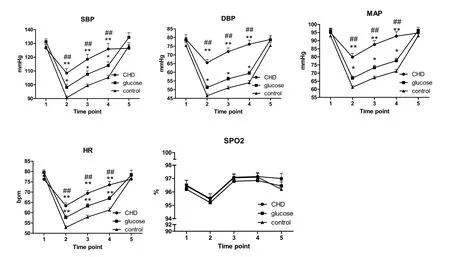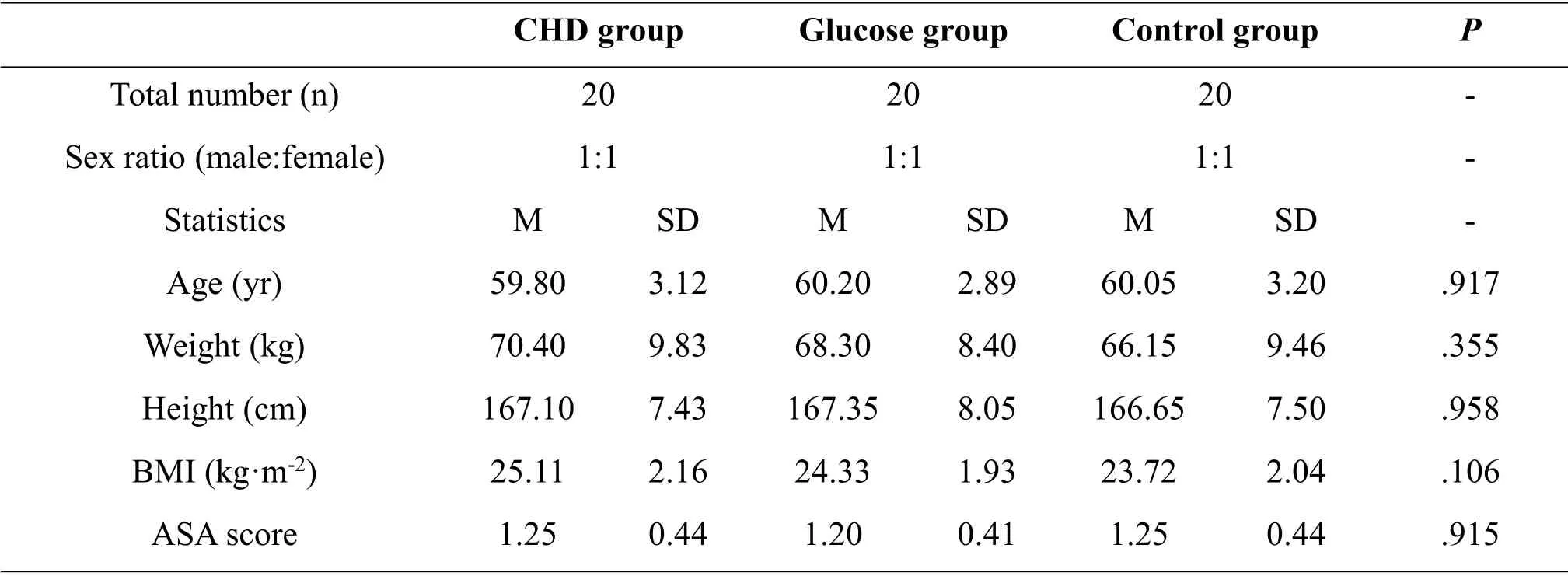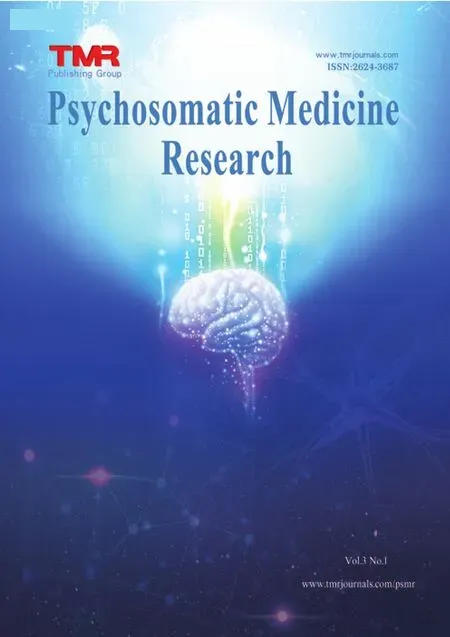The Effect of Carbohydrate Drinks Before Painless Colonoscopy on Hemodynamic Stability and Comfort of Elderly Patients:A Randomized Controlled Study
2021-10-20LingXiaLiDongHuaZhangHaoZhangPingJiangGuangChaoWangYingYao
Ling-Xia Li,Dong-Hua Zhang,Hao Zhang,Ping Jiang,Guang-Chao Wang,Ying Yao*
1Naval Military Medical University,Shanghai,China.2Department of Biochemistry and Psychopharmacology,Shanghai Mental Health Center,Shanghai Jiaotong University School of Medicine,Shanghai,China.3Shanghai Key Laboratory of Psychotic Disorders,Shanghai Mental Health Center,Shanghai Jiao tong University School of Medicine,Shanghai,China.
#Ling-Xia Li and Dong-Hua Zhang have contributed equally to this work.
Abstract Purpose:Elderly patients underwent a sharp decline in blood pressure after the induction of anesthesia and were subjected to many kinds of discomfort before and after painless colonoscopy.The aim was to investigate if the oral intake of carbohydrate drinks(CHD)alleviated side effects during colonoscopy.Methods:Sixty patients were randomly assigned to the CHD group (A) to receive preoperative CHD,the glucose group(B)to receive preoperative sugar drink,and the fasting control group (C)to undergo preoperative fasting for at least 10 h.The primary outcomes were hemodynamic data before anesthesia(T1),one(T2)and five(T3)minutes after induction,the beginning (T4) and end (T5) of colonoscopy.The secondary outcomes were hunger,thirst,stomach discomfort,anxiety,and fatigue in patients,who were assessed using a visual analog scale.Additionally,postoperative parameters such as blood glucose level were evaluated.Results:Intraoperative hemodynamics (data on T2,T3, and T4) including systolic blood pressure,diastolic blood pressure,mean arterial pressure,and heart rate was higher in the CHD group than in the glucose and fasting group(P <0.01).Preoperatively alleviated feelings of hunger and thirst were found to be in the CHD group compared with the glucose(P<0.01 in hunger and P<0.05 in thirst)and fasting group(P<0.01).The blood glucose level in the CHD group was lower than that in the glucose group(P<0.01)and higher than in the fasting group(P<0.01).Critically,oral CHD did not affect the process of colonoscopy.Conclusion:Oral intake of CHD stabilizes perioperative hemodynamic change and alleviates preoperative discomfort during painless colonoscopy.
Keywords:Carbohydrates,Hemodynamics,Patient comfort,Fasting
Introduction
Painless colonoscopy is a procedure for colonoscopy in patients injected with intravenous anesthetics when undergoing colonoscopy.Adequate anesthesia improves the tolerance and stress response to harmful stimuli of the patients,thereby eliminating the fear and discomfort so that endoscopy procedures can be conducted smoothly [1-3].However,it is still common for Chinese doctors and nurses to keep the traditional fasting concept indicating that adult elective surgery patients must abstain from solid food for 8–12 h and avoid liquid food for 4 h before surgery in clinics[4-6].Prolonged fasting will cause intense hunger,thirst,and discomfort before surgery it can also cause anxiety and other unwanted emotions [1].Patients who must undergo enteroscopic surgery experience stomach problems,and prolonged fasting will also lead to stomach damage [7].Moreover,long-term ban on eating and drinking is more harmful to the aged patients,leading to severe consequences such as intraoperative hypotension and even acute kidney injury[8],which also correlate with metabolic disorder and coronary heart disease [9].Thus,adverse factors have both physical and psychological impacts on patients,hindering the rapid recovery of patients after surgery.
Currently,the most acknowledged standard of preoperative fasting by the American Society of Anesthesiologists (ASA) in 2017 suggests that fasting for clear fluid can be adjusted to 2 h before the surgery among both adults and children [10].Additionally,the patients can have soft drinks,including clearwater,sugar solution,juice,etc.However,beverages with different compositions have different effects on the stability of intraoperative hemodynamics,the occurrence of discomfort by fasting,postoperative nausea and vomiting (PONV),and the operation of colonoscopy [11].Numerous studies have shown the benefits of oral carbohydrate drink(CHD)in colorectal surgery [1],gastroscopy [2],thyroid surgery [3],etc.The study was designed and conducted to evaluate the effect of CHD on the intraoperative changes in hemodynamics during painless colonoscopy,the incidence of preoperative discomfort by fasting,the incidence of postoperative pain and PONV,the intestinal emptying and blood glucose level compared with the strategies concerning oral intake of glucose solution and traditional fasting,optimize the preoperative fasting strategy in elderly patients undergoing colonoscopy and promote the view of enhanced recovery after surgery(ERAS).
Methods
Study design
From Sep.2018 to Apr.2019,sixty patients aged 55 to 65 years and defined as ASA physical status I or II,who were enrolled from the Department of Gastroenterology (Changhai Hospital,the Naval Military Medical University),underwent painless colonoscopy with 1:1 sex ratio,conditions of nutrition are similar.The exclusion criteria included severe cardiovascular or respiratory diseases,liver and kidney dysfunction,diabetes,hypertension,and patients with communication difficulties.The height and weight of patients were measured 2 h before colonoscopy,and the body mass index(BMI)was calculated by dividing the weight by height squared.Before the operation,according to the oral intestinal preparation method for magnesium sulfate,the quality of bowel cleaning like the Boston bowel preparation scale (BBPS) were all above 8.
Setting and sample
The patients enrolled were randomly divided into three groups using the random number table generated by www.randomization.com:A group(CHD group,n=20,male:female=1:1),B group (glucose saline group,n=20,male:female=1:1),and the C group (fasting control group,n=20,male:female=1:1).All patients implemented the routine-fasting procedure 10 h before colonoscopy,while the patients in the group’s A or B were orally given CHD (5 ml/kg)or 5%glucose saline(5ml/kg)2 h before colonoscopy.
Ethical consideration
The study was approved by the appropriate Institutional Review Board and Changhai Hospital Ethics Committee (Shanghai,China;approval no.CHEC2018-080),and was registered at the Chinese Clinical Trial Registry (www.chictr.org.cn;identifier:ChiCTR1800015899).
Measurements
The outpatients were advised not to fast 10 h before colonoscopy.The subjective feelings of hunger,thirst,stomach discomfort,anxiety,and fatigue were assessed using a 100-mm visual analog scale (VAS) 30 min before the operation.To be specific,a 100 mm horizontal line was drawn and anchored at either end with “no symptom” (score of 0) and “the worst imaginable symptom” (score of 100) for the parameters to be evaluated.The patients were told to mark with a point or line to indicate their intensity for discomfort measurement.Blood pressure (BP),heart rate(HR),and oxygen saturation(SpO2)were recorded using the multifunctional monitor (Mindray Dpm6 Bedside)before anesthesia using(T1)as the baseline.
The induction of general anesthesia was conducted using intravenous fentanyl (1 ug/kg) and propofol (2 mg/kg).The target control infusion (TCI) with infused propofol (approximately 1–2 mg/min) and an intravenous bolus of fentanyl (approximately 50 μg/h)was applied to maintain anesthesia.Nasal cannula was used to deliver supplemental oxygen (2 L/min) for patients.During the colonoscopy procedure,approximately 200 to 250 mL Ringer solution of IV fluids were administered with the induction and maintenance of anesthesia.BP,HR,and SpO2was measured at 3-min intervals,and the monitoring data 1 min after induction (T2),5 min after induction (T3),and the beginning of colonoscopy(T4)were all applied using static analysis.
TCI was stopped 5 min before the end of the operation.BP,HR,and SpO2were immediately recorded at the end of operation (T5).VAS with a 100-mm horizontal line was also used to evaluate postoperative pain after colonoscopy in patients.The occurrence of PONV and operative completion was analyzed once the patients awoke.Additionally,blood glucose level was measured 2 h after colonoscopy,and intestinal emptying during the operation was assessed via live video recording.
Data collection
The primary outcome of the hemodynamic change includes systolic blood pressure (SBP),diastolic blood pressure(DBP),mean arterial pressure(MAP),and HR among the three groups.The secondary outcomes were perioperative SpO2,preoperative complainants of thirst,hunger,stomach discomfort,anxiety,and fatigue by VAS(100-point scale)half an hour before colonoscopy,and postoperative data including pain by VAS(100-point scale),the rate of PONV and colonoscopy completion,blood glucose concentration 2 h after operation and intestinal emptying status.
Data analysis
The mean and SD were presented in tables,while the mean and SEM were presented in figures.Student’s two-tailed t-test or ANOVA was used to determine the statistical significance within two groups followed by Bonferroni’s correction if there were more than two groups.Non-parametric analyses were conducted using Kruskal-Wallis one-way analysis.All analyses were conducted using Graphpad Prism (version 5.0).P<0.05 was considered statistically significant.Specifically,*P<0.05 and **P<0.01 was compared with the control group;#P<0.05 and##P<0.01 was also compared with the glucose saline group.
Results
Baseline characteristics
Sixty colonoscopy were conducted over a period of 7 months,and there were 20 patients in each group.Groups were comparable in terms of age,sex,weight,height,BMI,and ASA physical status (P>0.05).There were no significant problems before,during,or after colonoscopy(Table 1).
The effect of CHD on perioperative hemodynamic fluctuation
All outpatients assigned to the CHD group tolerated the oral solution without adverse events such as allergy,intolerance,and other clinical signs.There was no significant difference among the three groups regarding preoperative SBP,DBP,MAP,and HR before induction (T1),postoperative SBP,DBP,MAP,and HR after the operation (T5).However,SBP,DBP,MAP,and HR were significantly higher in the CHD group a minute after induction (T2),5 min after induction(T3),and at the beginning of colonoscopy(T4)during the operation when compared to either the glucose group (##P<0.01) or the fasting control group(**P<0.01).Additionally,SBP,DBP,MAP,and HR were significantly higher in the glucose group during the intraoperative process (T2,T3,and T4) when compared to the control group(*P<0.05 in SBP,DBP,and MAP;**P<0.01 in HR).Nevertheless,there was no difference in perioperative SpO2among the three groups(Figure 1).

Figure 1 The effect of CHD on perioperative hemodynamic fluctuation
The effect of CHD on preoperative discomfort
In the preoperative assessment,complaints of hunger and thirst were lower in the CHD group compared with the glucose group (P<0.01) and the fasting control group (P<0.01).Additionally,we found that feelings of hunger and thirst in the glucose group indicated a higher value than those in the fasting group(P<0.01).While oral intake of CHD partially alleviated the feelings of stomach discomfort and anxiety when compared with the glucose group,there was no statistical difference between the CHD and glucose group.In comparison to the fasting group,oral intake of CHD and glucose attenuated the feelings of stomach discomfort and anxiety (P<0.01).Finally,there was no statistical difference found in terms of fatigue among the three groups(Table 2).
The effect of CHD on postoperative parameters
As colonoscopy is a minor procedure compared to other surgeries,postoperative pain levels by VAS were low,and there was also little difference in the three groups.Additionally,the rate of PONV after colonoscopy was low (<5% overall) in the three groups,while PONV did not happen in the CHD group.As indicated,the images obtained during colonoscopy in the three groups were similar.Accordingly,no difference was found among the three groups in the rate of colonoscopic completion and intestinal emptying.The blood glucose level two hours after colonoscopy in the CHD group was lower than in the glucose group(P<0.01),and the level in the CHD and glucose group was higher than in the fasting group (P<0.01)(Table 3).

Table 1 Demographic characteristics of the groups

Table 2 Comparison of preoperative discomfort in three groups

Table 3 Comparison of postoperative parameters in three groups
Discussion
Colonoscopy is currently the preferred screening method used on aged patients to diagnose colon and rectal cancer,but it is associated with pain and discomfort [12].Elderly patients can easily get hypovolemia due to preoperative fasting,gastrointestinal preparation,etc [13].Additionally,intravenous infusion of fentanyl and propofol at the induction period of general anesthesia causes hypotension and bradycardia [14-16].Chinese doctors and nurses keep the traditional fasting concept indicating that adult elective surgery patients should abstain from solid food for 8–12 h,and from liquid for 4 h before surgery to develop the view of ERAS [17],studies to evaluate the effect of oral CHD was conducted.This is the first study that compares intraoperative hemodynamic change and oxygen saturation among the CHD,glucose,and traditional fasting strategies in colonoscopy.Oral CHD could significantly reduce the hemodynamic change (BP &HR change) compared with the sugar saline group and the fasting group.Additionally,the sugar saline group could significantly reduce the hemodynamic change compared with the fasting group.However,there was no significant change in oxygen saturation among the three groups.This indicates that preoperative oral intake of carbohydrates is effective in stabilizing hemodynamics of patients in colonoscopy.
Few decades ago,preoperative fasting strategies underwent various modifications.The fasting for solid and liquid after midnight was still the standard protocol for all patients until 1990 [18].Currently,most Chinese specialists have adhered to the basic fasting routines of 6 h for solid and 3 h for liquid under the guidelines from different associations in anesthesiology (one applicable guideline in Chinese issued in 2014).However,carbohydrate deficiency in bodies leads to postoperative insulin resistance,increase in catabolism,inflammation,and obtaining delayed recovery after colonoscopy[19,20].Therefore,the blood glucose level was measured and analyzed 2 h after colonoscopy among the three groups.It was found that the blood glucose level 2 h after colonoscopy in the CHD group was lower than that in the glucose saline group,while it was higher than that in the fasting group.It indicated that oral carbohydrate could effectively improve the symptoms of hypoglycemia caused by prolonged fasting and there was no risk of hyperglycemia due to excessive intake of sugar components.Additionally,we analyzed the intestinal emptying by gastroscopy during colonoscopy,and found that there was no significant difference in intestinal emptying between the three groups.Thus,oral intake of carbohydrates did not affect colonoscopy.
Elderly patients can easily develop feelings of thirst,hunger,stomach discomfort,and even anxiety due to many factors such as long-time fasting and gastrointestinal preparation [1,3,8].Therefore,this study used subjective VAS to evaluate the feelings of thirst,hunger,stomach discomfort,anxiety,and fatigue half an hour before colonoscopy among the patients,to show that oral intake of carbohydrates could alleviate the feelings of thirst,hunger,stomach discomfort,and anxiety before colonoscopy,it is especially better than the use of glucose saline.
In summary,this study suggests that preoperative oral intake of carbohydrates can reduce preoperative discomfort in elderly patients,stabilize hemodynamics and stabilize blood glucose.Additionally,oral CHD does not affect gastrointestinal emptying and thus does not affect colonoscopy.The data render more evidence and advice concerning fasting before colonoscopy in elderly patients and how to prepare colonoscopy procedures in a better way.
Conclusion
Oral intake of carbohydrate drinks 2 h before the induction of anesthesia stabilizes perioperative hemodynamic change and alleviates preoperative discomfort during painless colonoscopy.Additionally,CHD allows for normal colonoscopic procedures and hinders blood glucose increase when glucose is taken orally.Preoperative CHD should be a standard practice accepted by nurses,surgeons,and anesthesiologists in painless colonoscopy.Elderly patients are prone to be hypertensive subjects.Patients with hypertension are excluded from this study.It is possible that CHD is also effective in stabilizing hemodynamics in hypertensive patients,and such patients should be enrolled in further research.
杂志排行
Psychosomatic Medicine Resesrch的其它文章
- Is It the Obligation of People with Hiv/Aids to Inform Spouses and Sexual Partners
- Going-out Behaviors of Patients with Chronic Diseases When Purchasing Drugs During Covid-19
- Path Analysis of the Impact of Covid-19-Related Stress Response on Phobia and Anxiety Experienced by College Students
- Impact of Risk Perception about COVID-19 on the Coping Behavior of the Elderly:Mediating Role of Self-Efficacy
- Comparison of Mental Health Status and Behaviour of Chinese Medical and Non-Medical College Students During the Coronavirus Disease 2019(Covid-19)Pandemic
